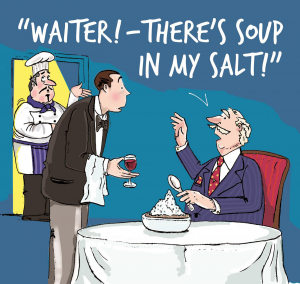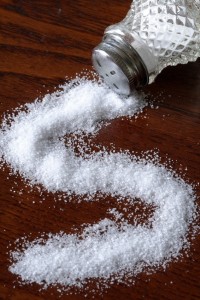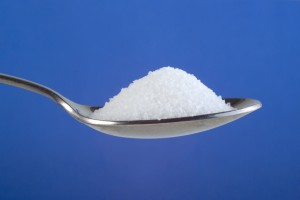 For the first time, new research revealing the shockingly high levels of salt purchased in chain restaurants and celeb eateries throughout the country has seen Jamie’s Italian rate as poorly as Pizza Hut, while 62% of the meals surveyed were deemed high in salt.
For the first time, new research revealing the shockingly high levels of salt purchased in chain restaurants and celeb eateries throughout the country has seen Jamie’s Italian rate as poorly as Pizza Hut, while 62% of the meals surveyed were deemed high in salt.
The study undertaken by Consensus Action on Salt and Health (CASH) and released today to mark the start of Salt Awareness Week saw meals from popular restaurants analysed by testers, with mystery diners taking their ‘doggie-bags’ straight to labs for analysis.
Any meal which contains more than 2.4g of salt qualifies for a ‘red traffic light’ salt rating and 358 of the 667 meals surveyed had this level of salt or more, while 13 meals had more than double that.
Alongside the analysis, research of diners shows that more than half find restaurant meals too salty, while 69% think guidelines should be introduced for chefs to limit the amount of salt they can use in meals.
Close to two thirds say they would like to see salt levels indicated on menus when eating out, while almost three quarters agree that restaurants in their local area don’t do enough when it comes to telling them about the ingredients in their food. Furthermore almost a fifth said it would help if salt shakers were removed from the tables.
Furthermore, 90% believe that local restaurants/cafes should let them choose if they want to add salt to their meal or not.
Danielle Robinson has interviewed Katharine Jenner of CASH on behalf of Patientalk.Org
ROBINSON: The recent study by the European prospective investigation into cancer and nutrition suggested that it is processed meat per say which is the problem rather than salt as this reports suggests. Which is correct?
 JENNER: Well it would be lovely to be able to say there’s only one problem and if we stopped eating processed meat that would fix everything but unfortunately with nutrition there always lots of interlinking factors. So one thing with processed meat is that is has too much saturated fat, too many toxins from the way they process the meat and also too much salt. The study itself said it is very difficult to separate what was the exact problem but certainly the fact that we eat a lot of processed meat is a problem but actually salt in itself puts up our blood pressure which leads to strokes and heart attacks so it has an independent effect of saturated fat and all the other problems of processed meat. So unfortunately its quite likely that salt is a problem, saturated fat is a problem, too much sugar is a problem, smoking’s a problem, all these things and they will all have an impact on our health. So I think it’s good to consider them all together.
JENNER: Well it would be lovely to be able to say there’s only one problem and if we stopped eating processed meat that would fix everything but unfortunately with nutrition there always lots of interlinking factors. So one thing with processed meat is that is has too much saturated fat, too many toxins from the way they process the meat and also too much salt. The study itself said it is very difficult to separate what was the exact problem but certainly the fact that we eat a lot of processed meat is a problem but actually salt in itself puts up our blood pressure which leads to strokes and heart attacks so it has an independent effect of saturated fat and all the other problems of processed meat. So unfortunately its quite likely that salt is a problem, saturated fat is a problem, too much sugar is a problem, smoking’s a problem, all these things and they will all have an impact on our health. So I think it’s good to consider them all together.
ROBINSON: What role does salt take in the curing food process?
JENNER: So not that many foods are cured now actually so it tends to be things like smoked salmon and certain types of meat and what happens is the salt is put in the food and it draws in the water and it stops any more microbial activity happening which means that you can eat the food as it is without it needing to be cooked. Generally for foods to be preserved in salt it has to be about 15% salt so that’s things like anchovies, some smoked salmons that are really very salty products and certainly not the norm.
ROBINSON: A meal is a bit of an ambiguous concept as a unit of measurement to be used. Could you qualify it a bit more for us?
JENNER: So we considered a meal to be a main meal that was served at any of these café, restaurant chains of fast food, so it tends to be a meal centre. So unless the meal came with side dishes such as chips or potato, it was whatever was considered to be a main meal and that was, as stated on the, in the restaurant. So a meal is effectively whatever the fast food restaurant, café chain said was a main meal and we used their basis for it. A meal size could vary between perhaps 300 and 600 gram portions sizes.
ROBINSON: Could you talk us a little bit through about the research. How many restaurants were sampled and how did you select those?
JENNER: So we looked at the list of the top restaurants in the UK, the most popular restaurants in the UK and we found any nutritional information that was available online so a lot of the restaurants, cafes and fast food chains had nutrition information available online so we extracted all of that information. The remaining popular restaurants such as Pizza Express, Café Rouge, I can’t think what the other ones were, pus all these celebrity ones we went in there and sampled products ourselves. So we got hold of the menus separated out the main meals, numbered them from one to six or however many there were then we selected meals from that, then we went into the restaurants, purchased them, took them away for sampling and we don’t analyse results ourselves, that’s all done independently by a public analyst which is a trained professional body.
 ROBINSON: Over what period of time did that take place?
ROBINSON: Over what period of time did that take place?
JENNER: We did it over a week so within a one week period commencing the 14th of January we sampled all of the products.
ROBINSON: Do you know how many in total how many restaurants were included?
JENNER: We included 29 restaurants so that was chain restaurants, celebrity chief chain restaurants, fast food outlets and cafés.
ROBINSON: Is the concept of too salty becoming a common problem because it is in fact we are using far less salt?
JENNER: Well I think to say we are using far less salt would be an exaggeration. We are eating about 10% less salt than we were say, ten years ago. Salt reduction has been a very long and slow and gradual process and the idea is that people generally don’t notice the difference but as supermarket food salt levels are coming down we are actually starting to, our taste buds are starting to adapt and actually we are starting to find that food tastes too salty. So in the survey that we under took we found that over half of people were finding restaurant meals too salty because they have not made the same reductions that the supermarkets have and the also thing that the chefs should start taking some responsibility for our health and start reducing their salt levels as well.
ROBINSON: Could you tell us a little bit more about the idea of the red traffic light system? How was that worked out and by whom?
JENNER: Yes, so in the supermarkets now at the moment certainly Sainsbury’s, Co-Op and ASDA but by the end of next year the Department of Health has recommended all supermarkets carry this traffic light labelling. It means that at a glance you can see whether a product is high, medium or low in salt, fat, sugar or calories. It’s a really useful, helpful tool if just want to get a bit of an idea of what’s in your food and for salt in particular if gives you red traffic label if it’s over 1.5 grams per 100 grams or if it is over 2.4 grams per portion. So this means that for a meal if it is over 2.4 grams it would get a red traffic light. So you would know in a supermarket quite easily if you were buying a ready meal or a pizza or some other kind of food, that it was high in salt because it would have a red traffic light. That’s something that you wouldn’t know in a restaurant and it would be a really easy way to see at a glance what was in there.
ROBINSON: Do you think that’s what the value of it is to the typical consumer, that they can see it straight away?
JENNER: Yes, so it is a really easy, quick way of seeing what’s in your food and being able to make that choice. So if you just looked at the names of some of these foods you’d have absolutely no idea about how much salt was in them by just by looking at them. You can look for salty, traditionally salty ingredients so things like bacon, anchovies, olives and cheese in fact but really you wouldn’t know what was in them unless somebody told you because quite often the salt, we say it is hidden salt because you can’t taste it as much as you might think. So a lot of people think they are being very good at being able to tell how much salt is in things because they’re aware of this. They have salt in their chips or their crisps taste salty but actually a lot of sweet things can have salt in them and you have no idea. Our taste buds are actually not as sensitive as you might think so eating some of these main meals like the meatballs or the Wagamama soups might not taste that salty but it doesn’t mean they are not full of salt.
 ROBINSON: Would it not be better to study salt intact over a period of time rather than targeting restaurant meals which for most of us will be a one off or an exceptional event?
ROBINSON: Would it not be better to study salt intact over a period of time rather than targeting restaurant meals which for most of us will be a one off or an exceptional event?
JENNER: Well we were very careful to include in our study not just exclusive, expensive restaurants. We looked at the ones the people do go to every day and they are exceedingly popular. So in fact three meals a week are eaten out of the home so that might be breakfast, lunch or dinner, so it is not really a rare thing and particularly people who do eat out tend to eat out more often, so not everybody eats out all of the time but there are some people who eat out a lot more. For them certainly, it will be very important. We do try and track what people are eating over time. The Department of Health look at salt intakes and they’ve worked out that we are eating an average of about 8.1 grams which is a lot more than the recommended 6 grams a day and we ourselves at CASH try and have a look at what’s going on in the supermarkets so we try and keep track on what’s going on and we found that supermarkets salt levels are coming down slowly so that will impact on our diet and we just thing it’s time for the restaurants to start doing the same.
ROBINSON: Could you explain to us why medically salt is so dangerous and if it is, should we not completely exclude it from our diet?
JENNER: So salt is made up of sodium and chloride both to essential minerals. You can’t cut sodium out of your diet, you will die. It has a very important function in water balance and electro-function of the cell. So we certainly need to have some sodium but less than about a gram a day and we’re currently eating more like 8 or 9 grams. So the problem with salt is that it puts up our blood pressure, you’ll know if you eat too much salt because you become incredibly thirsty, it’s sort of a thirsty mineral. It holds onto water in your cells and makes it harder for the heart to push it around. So that’s what puts up our blood pressure over time and that’s happening every day and it’s also quite hard for the kidneys to secrete all this extra salt so the extra work on your kidneys puts a strain on them and hence the link to kidney disease. Sodium is also known to react very poorly with calcium and causes it to excrete calcium from the bones, so it’s linked to osteoporosis and kidney stones through that mechanism as well. So the main problem with salt is that it puts up our blood pressure which leads to strokes and heart attacks and heart failure which are the biggest killers in the UK, so anything we can try and do to reduce blood pressure at a population level would be really helpful. Currently about 2/3 of the population have got higher blood pressure and half of those people don’t even know it which is why it’s called the silent killer. So to suggest that anyone with high blood pressure can do something about it and reduce their risk is not that easy because it’s very hard to do something about it when you don’t even know that you have it.
ROBINSON: What do you think about the idea of removing salt shakers from the table, do you think it’s a bit nanny state gone mad?
JENNER: Well I don’t think we’re suggesting that if you remove salt shakers you make them not available. The thing is with salt is that it’s a very habitual thing that we do, we naturally sit down at the table and put some salt on our food. I don’t know why that is, it’s always been like that, I think we always had it on the table from childhood, but there’s no reason why we should automatically reach for the salt shakers. So much research has shown that if you don’t have the salt shaker in front of you, you actually forget about it and don’t think about adding. So just one way that might help us all to add a little bit less salt and get used to the flavour of less salt would just be to have them out of sight and have them available on request and that’s a department of health recommendation.